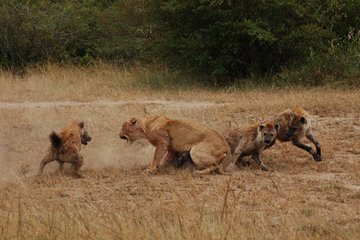Collaborative Research Grant Winners Announced!
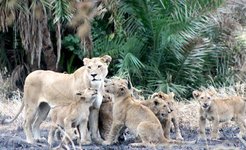
The African lion (Panthera leo) is the only group-living cat species.
Borrego and Finerty’s project aims to identify the conditions under which sociality emerges and breaks down, by exploring variability in social structure and cooperation across lion populations living in habitats with differing levels of resource richness. This project will integrate their individual strengths and skillsets, and develop their shared interest in combining novel field-based, data-driven, and theoretical approaches to studying carnivore biology.
Dr Natalia Borrego completed her PhD in Biology from the University of Miami in 2016, and is currently a postdoctoral researcher with the University of Minnesota Lion Research Center and postdoctoral teaching fellow with The American University in Cairo. Genevieve Finerty is a PhD candidate in the Wildlife and Conservation Research Unit at the University of Oxford, and will defend her doctoral thesis this coming October. Borrego and Finerty will join the Department for the Ecology of Animal Societies and officially begin their CRG-funded work in May 2021.
The idea for the CRG program was, in itself, a collaborative effort: Dr Ariana Strandburg-Peshkin, a research scientist in the Department and a Junior Research Group Leader at the University of Konstanz, first proposed the idea to Dr Meg Crofoot, the Director of the Department for the Ecology of Animal Societies, and the two developed the program together. Their intention was to fund small teams of post-doctoral scientists conducting research that addresses broad questions about how animal societies emerge and function.
Both Crofoot and Strandburg-Peshkin recognize the important role that collaboration has played in their own scientific careers, and they wanted to encourage collaborative research in their field, as well as further foster the principles of collaboration within the new Department for the Ecology of Animal Societies. “Particularly at the post-doc level, there were so few programs that encouraged collaborative science and actually made the resources available to allow it to happen,” explains Crofoot. Strandburg-Peshkin continues, “We also wanted to create an opportunity for post docs to develop a project that is truly their own, and to provide them with the job stability, research funding, and structural support they need to pursue it.”
Their project
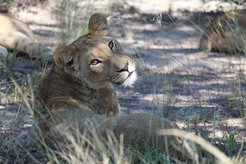
The full extent of variation in lions’ social behaviors and structure is not yet well understood.
Borrego and Finerty are interested in sociality, and want to know what factors lead to the emergence and breakdown of group living and cooperation, and what drives variation in how societies are structured. To answer these questions, they will study African lions, and explore how social structure and behavior vary across lion populations living under different environmental conditions, including different levels of resource richness and exposure to human disturbance.
They will combine their own field data collection with long-term datasets of their collaborators to describe and explain the variability in lion social structure and fission-fusion dynamics across their geographic range. In particular, they’re interested in the extent to which lions at different sites, living under different ecological conditions, cooperate during group hunts. By identifying the ecological factors that influence variation in hunting strategies, and the energy expenditure associated with these different strategies, Borrego and Finerty will be able to better understand the costs and benefits of group living and cooperation in this territorial species.
“Most of what we know about lions… comes from the Serengeti ecosystem,” explains Borrego, “and [the Serengeti lions] are really social, they’re [a] relatively dense [population] and live in relatively larger social groups, compared to other areas… so you’d expect to see a lot of cooperation.” However, African lions’ geographic distribution is scattered over the grassy plains and savannahs of sub-Saharan Africa – encompassing habitats with varying levels of resource richness. It is not yet well understood the extent to which lion sociality may differ across these different habitats.
Borrego and Finerty’s primary study site will be in the Khutse Game Reserve in Botswana, where they will be partnering with the organization Leopard Ecology & Conservation. In contrast to their well-studied conspecifics in the Serengeti, lions in the Khutse Game Reserve live at lower densities, have some of the largest home ranges recorded, and are much less social – all factors that make them much more difficult to study. This is especially true when it comes to studying group hunts, an unpredictable occurrence that is exceptionally difficult to observe and fully document. Collaring only yields the individual trajectories of particular animals – not entire groups, and definitely not the prey animals’ movements. To overcome these boundaries, Borrego and Finerty will integrate data from a combination of traditional and novel field-based techniques, including camera trapping, GPS collaring, direct observation, and – most notably – animal tracking.
Traditional methods (with a twist)
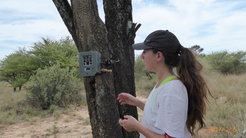
Borrego and Finerty (pictured) will use a combination of different field methods, including camera trapping, to collect data on lions in the Khutse Game Reserve.
Borrego and Finerty will work with the local San trackers, who are able to infer lions’ movement, behavior, and even some individual characteristics such as sex and age-class, using only tracks left behind on the ground. Importantly, the San trackers can also infer the movement and behavior of the prey animals. “It’s amazing the level of detail that [the San trackers] can pick up… they can really tell whether [the lions] were walking, stalking, what they were doing…. So, we can infer a lot of information about [the lions] from their tracks, which – in a low-density system – is really important because direct observation is so hard” explains Finerty. With respect to group hunting, Borrego describes how “[the San trackers] can find where a kill site was, go in, and then recreate the path that the lions took, and the prey species.”
Borrego and Finerty are also partnering with WildTrack, an organization that has developed a “Footprint Identification Technology” (FIT) tool which can infer the species, age-class, sex and individual identification of an animal from geometric profiles extracted from high quality photos of footprints. WildTrack is currently working to expand this technology to leopards and lions, and is trialing the use of AI technologies. Borrego and Finerty will contribute to these efforts by providing WildTrack with lion data, and in return, they’ll eventually be able to use the FIT tool to reliably identify individual lions from their paw prints.
By integrating the FIT tool to identify who is who, with the San trackers abilities to infer behavior and social interactions, Borrego and Finerty will be allowed unprecedented “observation” into the social dynamics of hunting behaviors among the Khutse lion groups. This aspect of their project is one that Crofoot is especially excited about. She describes how “the way in which this project builds on the traditional knowledge of San trackers… and complements and extends their expertise via cutting edge machine learning techniques – not to supplant the San trackers that are central to these research efforts, but to enrich their interpretations” was a particularly appealing aspect of Borrego and Finerty ’s proposed project.
Their collaboration
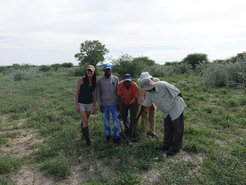
Borrego (pictured, far left) and Finerty’s project will integrate the unique skills of San trackers – including Dikgang, Mpho, Meno, and Gana (pictured here, from left to right) – and emerging AI technologies.
Borrego and Finerty first crossed paths 3 years ago, while both were studying African lions, and had overlapping networks of colleagues and contacts. Both scientists were essentially interested in the ultimate limits and drivers of lion behavior and sociality. Finerty was coming at these questions within a movement ecology and energetics framework, curious about how lions choose to allocate their energetic resources in terms of where they go and what behaviors they engage in. Borrego, on the other hand, was focused more specifically on the hunting context, and interested in the ecological conditions that favor lions choosing to cooperate rather than going it alone, and the different forms and levels of complexity of cooperative hunting behavior.
“We realized that our separate bits would be so much of a bigger picture if we could bring them together” recalls Finerty. Indeed, another aspect of Borrego and Finerty ’s project that really appealed to Crofoot was their collaborative relationship itself, and “the clear way that they had already integrated their individual interests into a mature, collaborative scientific vision.” Crofoot, Strandburg-Peshkin, and all members of the Department for the Ecology of Animal Societies look forward to having Borrego and Finerty join the team, and are excited to see what this collaboration reveals.
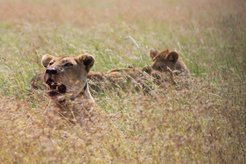
Borrego and Finerty’s project will focus in part on the variability in cooperative hunting strategies among lions.
More information about the Collaborative Research Grant program can be found at www.livingingroups.org
Written by: Alison M Ashbury, Scientific Writer in the Department for the Ecology of Animal Societies
Photos provided by: Natalia Borrego and Genevieve Finerty
















